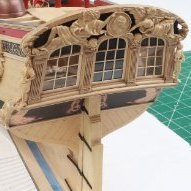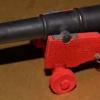-
Posts
3,084 -
Joined
-
Last visited
Reputation Activity
-
 Jaager got a reaction from Canute in Frigate vs. Sloop
Jaager got a reaction from Canute in Frigate vs. Sloop
Sloop is an ambiguous type designation. The vessel in Antscherl's book is the 18th century version.
There is a merchant /civilian vessel type.
In the 19th century - for the USN : Sloop-of-War - the class and distinctions within it 1st class, 2nd class, 3rd class based on size and number of guns.
They were also termed corvettes - there may have been a size distinction to which were called corvette. Corvettes were also a creature of the 18th century.
The defining characteristic was that they carried their guns on one deck. In general, the number of guns was 16-20. As the 19th century progressed, some or most had a spar deck. A sort of roof over the gun deck that made it easier to manage the rigging. No guns and not much of a bulwark.
A frigate carries guns on two levels (decks). There may only be 2-4 guns on the quarterdeck, but that makes it a frigate.
As the 19th century progressed, some frigates had their 2nd level guns removed, the upper bulwarks cut down, and perhaps the beams replaced using less substantial ones - to become razee corvette.
The RN changed the sparring on some of their brigs - Cruzier's were a subject for this. The main and fore masts were made less lofty and a full mizzen mast was added. For some reason they were called brig sloops. Though born brigs, they were now ship rigged and the same size as Sloop-of-War.
-
 Jaager got a reaction from mtaylor in Do you love Ancre Monographs and building models from them?
Jaager got a reaction from mtaylor in Do you love Ancre Monographs and building models from them?
This is a great idea.
Search " Commerce " and tag these too. All Gerard Delacroix inventory is now ANCRE. Even if this particular vessel seems to have defeated all attempts so far.
-
 Jaager got a reaction from tkay11 in Do you love Ancre Monographs and building models from them?
Jaager got a reaction from tkay11 in Do you love Ancre Monographs and building models from them?
This is a great idea.
Search " Commerce " and tag these too. All Gerard Delacroix inventory is now ANCRE. Even if this particular vessel seems to have defeated all attempts so far.
-
 Jaager got a reaction from Chuck in Do you love Ancre Monographs and building models from them?
Jaager got a reaction from Chuck in Do you love Ancre Monographs and building models from them?
This is a great idea.
Search " Commerce " and tag these too. All Gerard Delacroix inventory is now ANCRE. Even if this particular vessel seems to have defeated all attempts so far.
-
 Jaager got a reaction from druxey in Le Mercure by Planet_Jupiter - from ANCRE plans
Jaager got a reaction from druxey in Le Mercure by Planet_Jupiter - from ANCRE plans
It is an excellent job that you have done in laying your deck.
The darker raised strakes have an open grain that is similar to that of some Rock Elm that I have come across. It may want filling of the pores. I am not sure of the best way to do it though.
The blond species looks great. Adding trunnels is a modeler's convention that I enjoy. On a real ship they would not be all that obvious. They were often covered with plugs of the same wood as the decking, with matching grain.
The end grain of any species will usually be darker. If your trunnels were cored from the same blonde species, they would show. Using Pear, the contrast that comes from its end grain may be a more stark contrast than you really want. Just a thought before you step off that cliff.
-
 Jaager got a reaction from Gregory in Castello Boxwood Price?
Jaager got a reaction from Gregory in Castello Boxwood Price?
Mark,
A thought that came up when I read what Richard said about the inventory focus at Cooks: what they sell is a minor fraction, and a premium one at that, of their supplier sawmills' product.
If they have to buy the lot to get their premium stock, perhaps they have a backroom with the boring stuff we want. Or maybe they can tell you who they buy from and you can learn for us, where all the boring stuff goes? Who sells it?
As I read it, Madrone at Cooks is a species where they have to buy the lot. It is most likely from that mill that I contacted and their stock has experienced the special session in a kiln. They (the main mill) make a point of saying that if Madrone is not special kiln dried, and air dried instead, the result is mostly twisted toothpicks i.e. cupped, twisted, warped, and severely checked. If I have this correct, when you look, think of it as red colored boxwood.
-
 Jaager got a reaction from RichardG in Castello Boxwood Price?
Jaager got a reaction from RichardG in Castello Boxwood Price?
Mark,
A thought that came up when I read what Richard said about the inventory focus at Cooks: what they sell is a minor fraction, and a premium one at that, of their supplier sawmills' product.
If they have to buy the lot to get their premium stock, perhaps they have a backroom with the boring stuff we want. Or maybe they can tell you who they buy from and you can learn for us, where all the boring stuff goes? Who sells it?
As I read it, Madrone at Cooks is a species where they have to buy the lot. It is most likely from that mill that I contacted and their stock has experienced the special session in a kiln. They (the main mill) make a point of saying that if Madrone is not special kiln dried, and air dried instead, the result is mostly twisted toothpicks i.e. cupped, twisted, warped, and severely checked. If I have this correct, when you look, think of it as red colored boxwood.
-
 Jaager got a reaction from mtaylor in Castello Boxwood Price?
Jaager got a reaction from mtaylor in Castello Boxwood Price?
Mark,
A thought that came up when I read what Richard said about the inventory focus at Cooks: what they sell is a minor fraction, and a premium one at that, of their supplier sawmills' product.
If they have to buy the lot to get their premium stock, perhaps they have a backroom with the boring stuff we want. Or maybe they can tell you who they buy from and you can learn for us, where all the boring stuff goes? Who sells it?
As I read it, Madrone at Cooks is a species where they have to buy the lot. It is most likely from that mill that I contacted and their stock has experienced the special session in a kiln. They (the main mill) make a point of saying that if Madrone is not special kiln dried, and air dried instead, the result is mostly twisted toothpicks i.e. cupped, twisted, warped, and severely checked. If I have this correct, when you look, think of it as red colored boxwood.
-
 Jaager got a reaction from mtaylor in Sanding planking first layer
Jaager got a reaction from mtaylor in Sanding planking first layer
I did not want to know this, what with all the super fine grit abrasive media out there. A final sanding of layer one with 100-120 grit with provide the tooth required for PVA to hold the two layers of wood together. For a bonding surface, glass-like is not good.
-
 Jaager got a reaction from Chuck Seiler in Thin bullwarks
Jaager got a reaction from Chuck Seiler in Thin bullwarks
What I see: this is a POB build. The molds are 3 layer plywood.
Your dimensions are for the mold extensions that are inside bulwarks that are fully planked outside and inside? Just this between two layers support is 5/32" at the waterway and 4/32" at the rail?
Aside from making the already weak plywood even more fragile, it is not good practice to propagate and error and shave down the other supports.
The simple solution is to scab (PVA glue with careful clamping) a piece of 1/16" veneer on the inside to repair your overzealous sanding.
Woodcraft has 1/16" veneer packs. The two species that will be of use for other places on a ship model that will be seen are Black Cherry and Hard Maple.
A #11 shape knife blade and a steel straight edge should do what cutting needs doing.
A piece sawn from scrap Pine would do, as would any appropriate bit of wood from your scrap bin, or layered up curls from a full size hand plane on Pine. By asking this, I am guessing that you are where most all of us were when we started. Not many tools, no scrap bin.
-
 Jaager got a reaction from bruce d in Castello Boxwood Price?
Jaager got a reaction from bruce d in Castello Boxwood Price?
Mark,
A thought that came up when I read what Richard said about the inventory focus at Cooks: what they sell is a minor fraction, and a premium one at that, of their supplier sawmills' product.
If they have to buy the lot to get their premium stock, perhaps they have a backroom with the boring stuff we want. Or maybe they can tell you who they buy from and you can learn for us, where all the boring stuff goes? Who sells it?
As I read it, Madrone at Cooks is a species where they have to buy the lot. It is most likely from that mill that I contacted and their stock has experienced the special session in a kiln. They (the main mill) make a point of saying that if Madrone is not special kiln dried, and air dried instead, the result is mostly twisted toothpicks i.e. cupped, twisted, warped, and severely checked. If I have this correct, when you look, think of it as red colored boxwood.
-
 Jaager got a reaction from mtaylor in Castello Boxwood Price?
Jaager got a reaction from mtaylor in Castello Boxwood Price?
Mark,
Placing myself in your shoes for moment, but with my bias, what I see at Cook Woods:
Castello from what I seek, their stock looks sort of the opposite - too busy - and the price!!! My back of the envelope calculations tell me that I would need 8" x 2" x 60" to frame a hull the size of La Belle Poule.
Pear too busy and too expensive.
Holly the cutoffs box looks promising. @ 1/64 a 6" piece is 32' long -- if there is enough of the longer to make it worth getting, excellent for hull planking and can be dyed - black = a safe and user friendly Ebony substitute - icky yellow - the bottom treated planking -- blue - topside the deck if toned down from white.
Ceylon Satinwood take a look at the grain and cost, but think spars - Probably good for planking but the cost?
Yellowheart the same - I have some really yellow stock, but their photos have theirs a bit more toned down it should work for most any part of a ship. again cost?
Madrone When they say "a better Swiss Pear than Swiss Pear", my ears perk up. It is locally sourced for you. You can actually massage each board, look for color and straight grain, see if it is straight, tight, hard, no pores. If their advertising is actually correct, you have the potential for a golden ticket.
-
 Jaager got a reaction from thibaultron in Converting a Backyard Shed into a Model Workshop
Jaager got a reaction from thibaultron in Converting a Backyard Shed into a Model Workshop
I trust that you mean this is jest. Being 3 litres negative water balance in Piedmont Carolina in Summer-like temp sort of makes it difficult to maintain the necessary internal balance and not start to denature some temperature sensitive enzymes and receptors. I think beyond a certain age, our internal thirst safety drive can get to be below the strength of signal necessary to gain our attention.
-
 Jaager got a reaction from mtaylor in Thin bullwarks
Jaager got a reaction from mtaylor in Thin bullwarks
What I see: this is a POB build. The molds are 3 layer plywood.
Your dimensions are for the mold extensions that are inside bulwarks that are fully planked outside and inside? Just this between two layers support is 5/32" at the waterway and 4/32" at the rail?
Aside from making the already weak plywood even more fragile, it is not good practice to propagate and error and shave down the other supports.
The simple solution is to scab (PVA glue with careful clamping) a piece of 1/16" veneer on the inside to repair your overzealous sanding.
Woodcraft has 1/16" veneer packs. The two species that will be of use for other places on a ship model that will be seen are Black Cherry and Hard Maple.
A #11 shape knife blade and a steel straight edge should do what cutting needs doing.
A piece sawn from scrap Pine would do, as would any appropriate bit of wood from your scrap bin, or layered up curls from a full size hand plane on Pine. By asking this, I am guessing that you are where most all of us were when we started. Not many tools, no scrap bin.
-
 Jaager got a reaction from mtaylor in Converting a Backyard Shed into a Model Workshop
Jaager got a reaction from mtaylor in Converting a Backyard Shed into a Model Workshop
I trust that you mean this is jest. Being 3 litres negative water balance in Piedmont Carolina in Summer-like temp sort of makes it difficult to maintain the necessary internal balance and not start to denature some temperature sensitive enzymes and receptors. I think beyond a certain age, our internal thirst safety drive can get to be below the strength of signal necessary to gain our attention.
-
 Jaager got a reaction from catopower in Sovereign of the Seas: square tuck or round tuck?
Jaager got a reaction from catopower in Sovereign of the Seas: square tuck or round tuck?
I see this as a minor controversy that seems to have lasted about 250 years. Unless some misplaced plans from 1637 finally show up, there is no definitive resolution. It is all a best guess. It is unfortunate that it has taken on more significance than it deserves. It serves to divide into two camps, whose further differences are not evident. This is a large ship. There is much about it to cover in a book. For Frank Fox to disavow McKay's entire book over a couple of choices that are open to interpretation, seems excessive. Better to praise what works and footnote the disagreement. Then publish the alternative in NRJ with the alternate version of the plans.
I do not see this as being subject to vote, unless the voter is actually building a model of the ship. And, then, which ever choice is made should have no affect on how that model is judged, if it is an entry in a contest. A museum suit is entitled to use this as a decision point for an acquisition. Given the current fashion / fad exercised by museums, who knows how long it will be before even the possibility is a factor?
Now, valid vote or not, I see round. The continuation of the caulking seams in the whole white area, is my key. A flat tuck would have different planking. That said, them's some pretty wide boards between those seams. Did the painter actually see the ship? Did he use a poorly planked model of it as his source?
-
 Jaager got a reaction from mtaylor in Free hand lumber harvesting
Jaager got a reaction from mtaylor in Free hand lumber harvesting
These are a few ideas about what I would try, if I was doing this now.
Raw logs can be heavy and difficult to manage and secure. They are easier if they can be processed in the field.
I know that it is possible to a freehand rip cut to bisect a log with a chainsaw. A problem is holding a log that wants to roll and getting bottom clearance so that the chain is not also digging into the dirt.
Theoretical solution = a Bora Centipede ( smaller version) with 2x4 rails, right angle steel brackets and long screws. The wide footprint and portability looks promising.
A log can be then be held horizontal and at tabletop height.
A chainsaw will produce a fearsome waste to kerf, but if it this that or nothing, it is worth it and if correctly, the pith is removed - saving later problems with seasoning.
A good two stroke chainsaw is an excellent tool, but also expensive, a pain to start and maintain, their power can make kickback dangerous and more likely.
There are low cost electric chainsaws. Not as powerful, but good enough and they start when you want them to.
Given the cost of wood, the HF chainsaws are low cost enough to have a backup and treat as disposable.
A pickup truck, a small size portable generator and you are in business.
Were I younger, I would go hunting - Apple, Plum, Hornbeam, Hophornbeam, Honey Locust, Dogwood, Holly, even Buxus from old estates.
-
 Jaager got a reaction from Canute in How to seal acrylic paint?
Jaager got a reaction from Canute in How to seal acrylic paint?
Would shellac not also do the job? Not about resisting scratches, but an easy sealing layer.
Or conservators wax?
-
 Jaager got a reaction from Canute in Unimat or Sherline... your feedback, please...
Jaager got a reaction from Canute in Unimat or Sherline... your feedback, please...
Real Unimat have been out if production for a while now. Are you looking at a second hand machine?
Of late, some real junk has been showing up with the Unimat name. Lots of plastic instead of cast Al.
-
 Jaager got a reaction from mtaylor in How to seal acrylic paint?
Jaager got a reaction from mtaylor in How to seal acrylic paint?
Would shellac not also do the job? Not about resisting scratches, but an easy sealing layer.
Or conservators wax?
-
 Jaager got a reaction from jchbeiner in Shipybuilding Blender Model
Jaager got a reaction from jchbeiner in Shipybuilding Blender Model
Not much response, so far, so I will stand on a soap box, and speechify at bit:
For Blender, first you discover what the program can do. Then you dig until you find out how to do it - which tools to use. Then you practice until you can do it. I think this works better by doing the reverse of the education model ( i.e. learning all of the tools before begin a project.) The education model also has you learning functions that you will never need or use. Learning each tool as the specific task that needs doing comes at you, has more immediate feedback. By being out of school, passing the tests and the course, is no longer a motivating force. The motivation comes down to getting satisfaction from learning and doing, what needs to be done. It comes down to picking the needed tutorials up from wherever they are found, rather than a coherent and well written book. 3D computer graphics programs are messy to learn.
If you mean shipbuilding - this pretty much requires focusing of a specific ship or specific and narrow slice of time. There are monographs for individual vessels. There are reprints of books on shipbuilding that are of their time and place. They were written for a contemporary audience, to make money. They did not need to say that the work did not apply all that much to their grandfather's or even their father's ships. The purpose was progress and or advocacy of an individual bias, not history. The amount of information lost with the death of those who did it, because they either did not care to, or lacked the skills to, document it, is agonizing.
The number of "books" that were even written and level of detail they contain builds over time from zero to covering only the major points. https://nautarch.tamu.edu/shiplab/index_03treatises.htm
There are journal articles with shipbuilding information.
There are the concentrated and rewritten explanations of what the original books described. Most only cover a limited slice of time (Dodds and Moore).
To cover 1500 to 1860 in a single volume, the result would be very superficial, or if at real depth, require a forklift to move and a lifetime to write.
If you wish to build a comprehensive library covering the subject broadly, it will be expensive and large. The difficulty in obtaining out of print volumes that were published recently will prove frustrating. On the plus side, more and more of the originals are becoming available in electron form, because they are free of copyright limits.
The nature of this story is one of evolving tech, with many dead ends along the way. The mistakes could be and often were seriously consequential. This journey offers the chance for a glimpse of the challenges and methods of those for whom this was life or death.
A more focused request may produce more helpful information.
-
 Jaager got a reaction from Mark P in Unimat or Sherline... your feedback, please...
Jaager got a reaction from Mark P in Unimat or Sherline... your feedback, please...
Real Unimat have been out if production for a while now. Are you looking at a second hand machine?
Of late, some real junk has been showing up with the Unimat name. Lots of plastic instead of cast Al.
-
 Jaager got a reaction from mtaylor in Le Mercure by Planet_Jupiter - from ANCRE plans
Jaager got a reaction from mtaylor in Le Mercure by Planet_Jupiter - from ANCRE plans
It is an excellent job that you have done in laying your deck.
The darker raised strakes have an open grain that is similar to that of some Rock Elm that I have come across. It may want filling of the pores. I am not sure of the best way to do it though.
The blond species looks great. Adding trunnels is a modeler's convention that I enjoy. On a real ship they would not be all that obvious. They were often covered with plugs of the same wood as the decking, with matching grain.
The end grain of any species will usually be darker. If your trunnels were cored from the same blonde species, they would show. Using Pear, the contrast that comes from its end grain may be a more stark contrast than you really want. Just a thought before you step off that cliff.
-
 Jaager got a reaction from mtaylor in Shipybuilding Blender Model
Jaager got a reaction from mtaylor in Shipybuilding Blender Model
Not much response, so far, so I will stand on a soap box, and speechify at bit:
For Blender, first you discover what the program can do. Then you dig until you find out how to do it - which tools to use. Then you practice until you can do it. I think this works better by doing the reverse of the education model ( i.e. learning all of the tools before begin a project.) The education model also has you learning functions that you will never need or use. Learning each tool as the specific task that needs doing comes at you, has more immediate feedback. By being out of school, passing the tests and the course, is no longer a motivating force. The motivation comes down to getting satisfaction from learning and doing, what needs to be done. It comes down to picking the needed tutorials up from wherever they are found, rather than a coherent and well written book. 3D computer graphics programs are messy to learn.
If you mean shipbuilding - this pretty much requires focusing of a specific ship or specific and narrow slice of time. There are monographs for individual vessels. There are reprints of books on shipbuilding that are of their time and place. They were written for a contemporary audience, to make money. They did not need to say that the work did not apply all that much to their grandfather's or even their father's ships. The purpose was progress and or advocacy of an individual bias, not history. The amount of information lost with the death of those who did it, because they either did not care to, or lacked the skills to, document it, is agonizing.
The number of "books" that were even written and level of detail they contain builds over time from zero to covering only the major points. https://nautarch.tamu.edu/shiplab/index_03treatises.htm
There are journal articles with shipbuilding information.
There are the concentrated and rewritten explanations of what the original books described. Most only cover a limited slice of time (Dodds and Moore).
To cover 1500 to 1860 in a single volume, the result would be very superficial, or if at real depth, require a forklift to move and a lifetime to write.
If you wish to build a comprehensive library covering the subject broadly, it will be expensive and large. The difficulty in obtaining out of print volumes that were published recently will prove frustrating. On the plus side, more and more of the originals are becoming available in electron form, because they are free of copyright limits.
The nature of this story is one of evolving tech, with many dead ends along the way. The mistakes could be and often were seriously consequential. This journey offers the chance for a glimpse of the challenges and methods of those for whom this was life or death.
A more focused request may produce more helpful information.
-
 Jaager got a reaction from druxey in Converting a Backyard Shed into a Model Workshop
Jaager got a reaction from druxey in Converting a Backyard Shed into a Model Workshop
In thinking about the theory of the thing, it could have a real resistance to solar gain if there was a double roof. Leave the old trusses and plywood (or MDF) sheathing. Remove the old shingles - because of their weight. Add riser blocks to determine the gap and add a new roof with new rafters, sheathing and shingles over it. Active exhaust of the air in the gap would divert the heat. Of course the additional weight may crush the walls and the whole thing be a quantum singularity for your budget.
If there was sufficient insulation, a free standing ceramic space heater may be enough for most Winter conditions. Not shirt sleeve, but not ice sickle. I was going to try one in my garage, but I finished what I needed to do down there on La Renommee before it got cold. Then my Black Dog got aholdt of my initiative, so I did not need to buy one.













